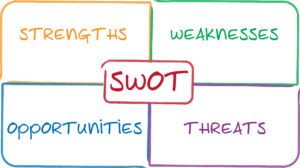A business of any size can analyze its internal strengthens and weaknesses and external opportunities and threats — a process known by its acronym, SWOT — to gain insight into the forces it does and doesn’t control and to set realistic goals.
Strengths and weaknesses are within a company’s control: Strengths give it a competitive edge; weaknesses give rivals an opportunity to gain the upper hand. Opportunities and threats originate outside the company, and a company only can control how to anticipate and react to them: Opportunities are conditions a business can leverage to its benefit, and threats are dangers that are best avoided.
One or more people can conduct the SWOT analysis, as long as the individual or group has a realistic assessment and fact-based knowledge of the company’s situation at the time of the review.
Starting with strengths, the SWOT team should decide what the company does better than its competitors or what critical resources or information it has that its rivals don’t. With weaknesses, the team should frankly examine what the company could do better to compete more profitably with other businesses in the same market.
A patent or other intellectual property is typically a strength. Other measures, like organizational culture, human resources, equipment and business structure, can be a plus or minus, depending on whether it limits or expands the company’s capabilities.
Deciding whether some business characteristic is a strength or weakness begins with how it’s defined. For example, having a highly specialized work force can help a business provide a broad range of services for a client, but a pool of specialists can disadvantage a company when the client needs generalists.
Benchmarking is another way to evaluate how a business stacks up against its competitors. If the benchmark for a car dealership is how many trucks it can sell each month, the dealership can’t just compare its own month-to-month sales. It must also know how many trucks each of its competitors are selling over the same period.
Likewise, external forces out of the business’s control can pose threats or present opportunities. These include changes in the overall economy or specific industry and the actions of a competitor. For example, a fluctuating dollar can raise or reduce profits for export-dependent businesses. A rise in interest rates can negatively influence borrowing but positively affect investment returns. And a competitor can add to the dynamic by changing its strategies or product lines.
Important considerations:
To best gauge the strength or weakness of a characteristic, make the comparison tangible — against an actual competitor rather than a hypothetical one.
If free-form brainstorming yields a long list, pare the results to about five core items for each SWOT category to maintain focus and set priorities.
Be specific about strengths and weaknesses. Rather than claiming market share as a strength, use numbers that represent the actual percentage. Likewise, use facts and reliable metrics to come up with an objective and realistic picture of where things stand.
Businesses can draw on many online resources to create a SWOT analysis, or they can attend a workshop hosted by one of New Mexico’s Small Business Development Centers. Consult www.BizCalendar.org or visit www.nmsbdc.org for workshop dates.
Download 494_SWOT Analysis Helps Businesses Plan for Growth PDF

